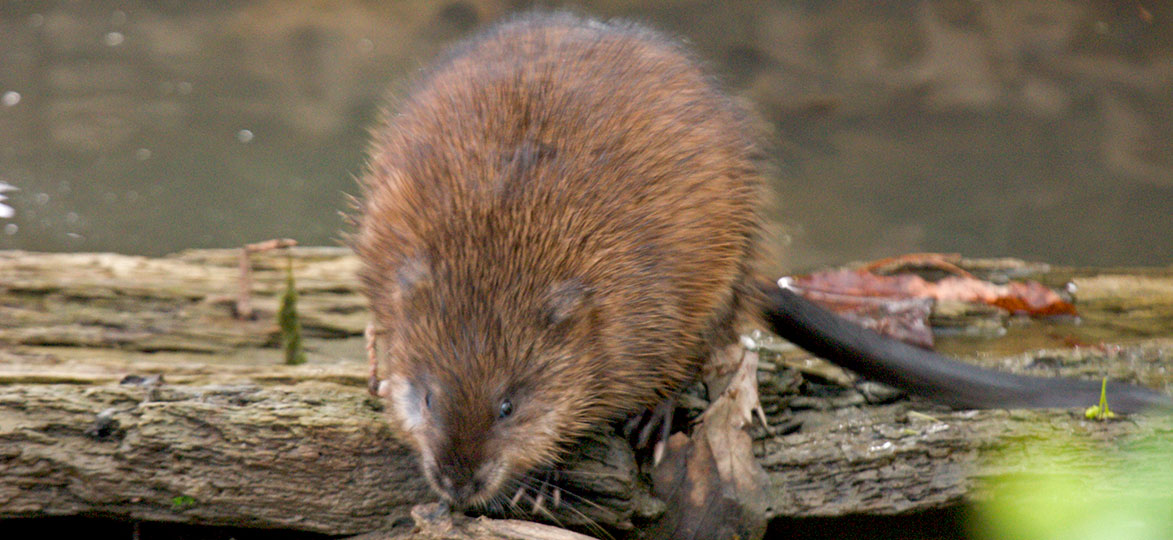
The muskrat (Ondatra zibethica) is a common semi-aquatic species found throughout Vermont. It is much smaller than a beaver, but larger than most other rodents. The muskrat also differs from the beaver in the shape of its tail; the muskrat has a long, vertically flattened tail, while the beaver's tail is flattened horizontally.
Like all furbearing animals, it has been trapped extensively. The muskrat is very abundant today, commonly found in nearly all of North America; from the Arctic Circle to the Gulf of Mexico and from the Atlantic to the Pacific coast.
Habitat
Muskrats are rarely far away from a freshwater source. Cattail marshes and swamps are the preferred habitats. These wetlands provide an excellent source of food, cover, and constant shallow water levels. Muskrats may dig shallow channels six to eight inches in depth to link deeper pockets of water. This provides better swimming routes for them to escape predators, better access to feeding areas, and easier travel to and from their homes. For this reason, muskrats often transform a marsh into a series of interconnected canals.
Muskrat houses are built at the end of a canal if the muskrat lives in a marsh. Those living in streams and rivers will build their houses into the bank. Decaying cattails and other aquatic plants are piled at the site along with mud from the canal digging, creating piles that can reach heights of three to four feet. Under the pile but above the water level a nest, or hollow, is created. These nests may be a foot or more in diameter and may be connected to neighboring tunnels that lead to another family's nest.
Larger muskrat houses will commonly have many entrances and muskrat families normally have more than one home and several smaller ones, known as huts. This multitude of shelters provides the muskrat with an additional level of security from predators.
Bank dens are burrowed into the side of a stream or river. An underwater entrance will mark the location of the den. This entrance helps to conceal the nest from land dwelling predators. Bank dens usually have a vent close to the nest, which provides air for the nest.
During hard winters, muskrats are sometimes forced to move and find new shelter wherever they can. Muskrats during winter are very vulnerable to predators because their black bodies stand out in contrast to the white snow covered landscape. In these conditions, muskrats run between areas of food, shelter, and cover. The amount of cover available to the muskrats will determine how high the predation toll will be.
Except under severe freezing conditions, muskrats survive by making use of loose "rafts" of grasses or floating debris. The muskrats can dig through these "rafts" to create an escape route or an air hole if the wetland is frozen over. During times of ice cover, muskrats can use this series of air holes to move from one feeding site to another. This ice cover will also protect them from predators that are unable to swim. At these times, the muskrats can travel back and forth, feeding on the fleshy roots and stocks of aquatic plants.
Reproduction
Muskrats, like other rodents, can reproduce quickly. In southern states breeding occurs year round, but in Vermont, the first litter is born in late April or early May. Normal life spans average three to four years.
During the breeding season, anal scent glands become enlarged and produce a noticeable, pleasing scent to other muskrats. This scent, also called musk, is how the muskrat got its common name.
The young are born blind and sparsely haired in a nest lined with dry vegetation. They are helpless except for their ability to hang tenaciously to a nipple. Eyes open about two weeks after birth when the young muskrats are well furred, and they now begin to swim and nibble on plants. They are weaned at two months and are nearly full size at six months of age.
Females born early in the spring may have a small family of their own in the fall of the same year. Four litters, of five or six young each, are common for muskrats annually.
Diet
Muskrats are predominantly herbivores, eating roots, tender stalks and the leaves of cattails, sedges and grasses. They may also graze in nearby fields and have been known to strip corn. In a woodland stream, more than half of their diet may consist of green algae taken from floating masses in set-backs or scraped from rocks. Freshwater clams, some fish, and crustaceans provide a minor part of their diet.
Management
Muskrats are abundant. They adapt well to a wide range of aquatic environments and are able to co-exist with humans. The high reproductive rate of muskrats is a major reason for their abundance. Historically, extensive trapping has had no negative effect on muskrat populations. On the contrary, muskrat trapping has helped limit crop damage and has also kept muskrat populations healthy.
Excessive muskrat populations can have harmful effects for both the muskrats and humans. An overly large muskrat population becomes stressed due to the lack of food. This makes disease more common among muskrats, including hepatitis, tularemia, and rabies. These diseases can devastate a muskrat population and the animals endure long- term suffering.
Some of these diseases can spread to humans from direct contact or through water. Muskrats can also damage and flood roadways and raise havoc with croplands. Regulated trapping helps to control the number of muskrats and is a practical and humane method for controlling over population. This management tool allows for the surplus animals to be harvested, which improves the overall health of the muskrat population.
Status
Muskrats can be found in almost any freshwater in Vermont, even small cattail swales. However, the largest densities are located in the extensive cattail marshes in Vermont's the Champlain and Connecticut River Valleys.
